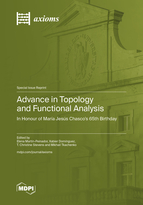Advance in Topology and Functional Analysis——In Honour of María Jesús Chasco's 65th Birthday
A special issue of Axioms (ISSN 2075-1680). This special issue belongs to the section "Geometry and Topology".
Deadline for manuscript submissions: closed (15 March 2022) | Viewed by 28572
Special Issue Editors
Interests: topology; functional analysis; topological groups
Interests: topological groups; duality of topological abelian groups
Interests: topological groups
Interests: topological algebra (semitopological, paratopological and topological groups); general topology
Special Issue Information
Dear Colleagues,
The interaction between topology and functional analysis has been a wellspring of powerful mathematical ideas and developments since the early stages of both disciplines. One of the many important programs originating within this framework can be described as borrowing some of the tools and concepts of topological vector space theory to study the structure and duality properties of abelian topological groups. Such a viewpoint turns out to be particularly useful, for instance, when dealing with Pontryagin duality and reflexivity outside the class of locally compact groups.
We are preparing a Special Issue in Axioms under the title “Topology and Functional Analysis”, to showcase recent work on these and related topics and pay tribute to María Jesús Chasco's mathematical career on the occasion of her 65th birthday. She has been a key contributor to the field for thirty years and maintains a very fruitful collaboration network with other researchers from Spain and abroad.
Full research papers on these topics, as well as review papers, can be included in this issue. Submitted papers should not exceed 20 pages and should follow the usual guidelines for publication in Axioms.
Prof. Dr. Elena Martín-Peinador
Prof. Dr. Xabier Domínguez
Prof. Dr. T. Christine Stevens
Prof. Dr. Mikhail Tkachenko
Guest Editors
Manuscript Submission Information
Manuscripts should be submitted online at www.mdpi.com by registering and logging in to this website. Once you are registered, click here to go to the submission form. Manuscripts can be submitted until the deadline. All submissions that pass pre-check are peer-reviewed. Accepted papers will be published continuously in the journal (as soon as accepted) and will be listed together on the special issue website. Research articles, review articles as well as short communications are invited. For planned papers, a title and short abstract (about 100 words) can be sent to the Editorial Office for announcement on this website.
Submitted manuscripts should not have been published previously, nor be under consideration for publication elsewhere (except conference proceedings papers). All manuscripts are thoroughly refereed through a single-blind peer-review process. A guide for authors and other relevant information for submission of manuscripts is available on the Instructions for Authors page. Axioms is an international peer-reviewed open access monthly journal published by MDPI.
Please visit the Instructions for Authors page before submitting a manuscript. The Article Processing Charge (APC) for publication in this open access journal is 2400 CHF (Swiss Francs). Submitted papers should be well formatted and use good English. Authors may use MDPI's English editing service prior to publication or during author revisions.
Keywords
- Topological groups
- Locally convex spaces
- Duality theory
- Topological algebra
- Descriptive topology
- Geometric topology
- Dynamical systems
Benefits of Publishing in a Special Issue
- Ease of navigation: Grouping papers by topic helps scholars navigate broad scope journals more efficiently.
- Greater discoverability: Special Issues support the reach and impact of scientific research. Articles in Special Issues are more discoverable and cited more frequently.
- Expansion of research network: Special Issues facilitate connections among authors, fostering scientific collaborations.
- External promotion: Articles in Special Issues are often promoted through the journal's social media, increasing their visibility.
- e-Book format: Special Issues with more than 10 articles can be published as dedicated e-books, ensuring wide and rapid dissemination.
Further information on MDPI's Special Issue polices can be found here.






